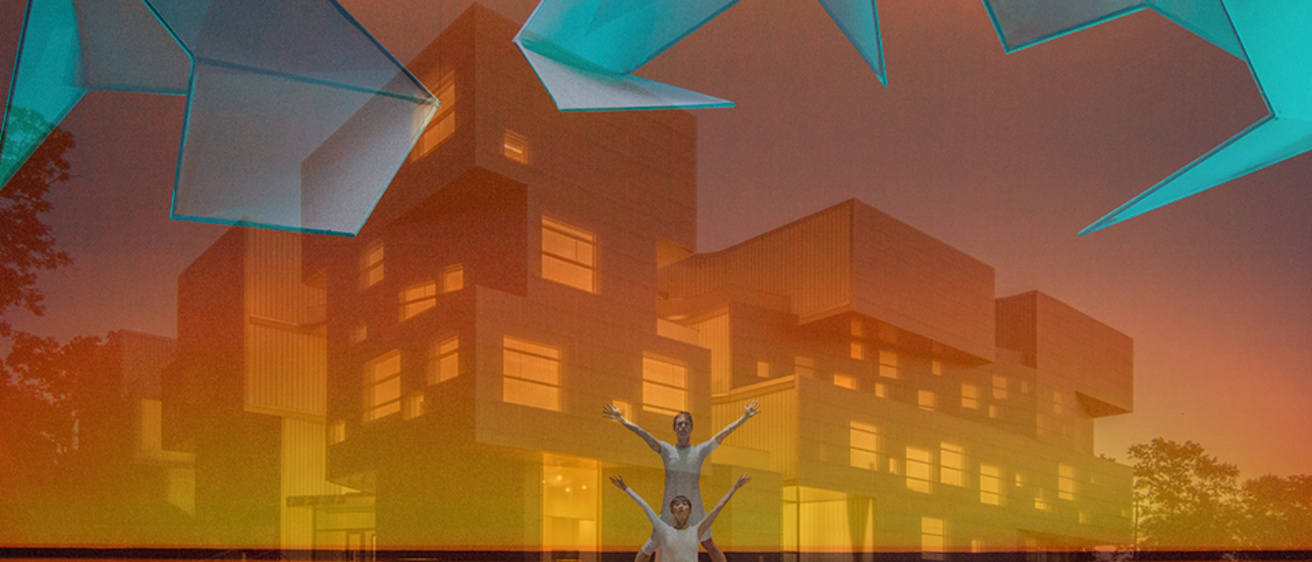If you’re playing a word-association game and someone says “dance,” you probably don’t blurt out “architecture!” but an upcoming performance at Hancher Auditorium might change that.
Jessica Lang Dance will perform a concert on March 23 at Hancher, and one piece in particular shares a unique connection with the University of Iowa. The critically-acclaimed Tesseracts of Time was created by choreographer Jessica Lang in collaboration with world-renowned architect Steven Holl, who has made a significant mark on the UI campus.
Jessica Lang Dance
What: The performance includes a collaboration between choreographer Jessica Lang and architect Steven Holl, who has designed two award-winning buildings on the UI campus.
When: 7:30 p.m. March 23
Where: Hancher Auditorium
Tickets: hancher.uiowa.edu
Holl is the architect behind two of the UI’s most celebrated structures—Art Building West, opened in 2006, and the new Visual Arts Building, which opened in October. Both have won awards for their architectural excellence and showcase the artistry in Holl’s craft.
That artistry made Holl a great collaborator for Lang, who was approached by the Harris Theater in Chicago to create a cross-collaborative dance for the Chicago Architecture Biennial in 2015.
“I always have an interest in collaborating,” says Lang, whose company will also lead a pair of masterclasses for UI ballet students on March 22. “It was a natural fit because of the work I already do with different types of visual art.”
The biennial’s organizers suggested Holl. Oddly enough, Lang lives near the Hunters Point Community Library, a Steven Holl building set to open soon in Queens, New York. Having already been aware of that project, Lang knew the two would be a good match.
Holl was eager to sign onto the project as well. It would allow him to explore other ways to use his creativity while exploring the similarities of two seemingly disparate art forms.
“I am interested in the blurred boundaries of the arts,” says Holl. “Architecture is one of the most permanent of the arts—a good campus building, for instance, should last more than 100 years. Dance is the most ephemeral of the arts. It can last just minutes. But both of these arts are spatial. The body moving through space is really the most important measure of architecture.”
Once paired, the two began talking about what inspires them, including various types of music and composers. They also shared a lot about their respective art forms, and from those conversations Lang found a concept on which to frame her choreography.
“We built the structure of the piece quite quickly,” Lang says. “Steven talked about how architecture, in the relationship to the ground, exists in four different ways. I immediately latched onto that.”
Tesseracts of Time has four segments that essentially follow the four basic types of architecture as described by Holl—under the ground, in the ground, on the ground, and over the ground. The end result is a 21-minute dance involving nine performers and a unique set design.
When conceptualizing the set pieces, Holl’s process for Tesseracts of Time did not differ much from his work on the Visual Arts Building and Art Building West, aside from the overall scale.
“All three projects began as 5-by-7 watercolor concept drawings,” Holl says. “All three aspire to an idea that drives a unique design; however, the real test for me is in the phenomena of light, space, material detail, and movement.”
Bringing Jessica Lang Dance to Hancher has long been on the agenda for Jacob Yarrow, Hancher’s programming director. He first saw her work performed in St. Louis several years ago and says he was instantly taken by what Lang considers her signature piece, The Calling, which also will be part of the March 23 performance. Having tracked the development of Jessica Lang Dance and the mutual connection to Holl, everything clicked at once—including the timing.
“To learn what a deep collaboration it was, and that they were part of the entire process together, that was really interesting,” Yarrow says. “The two Steven Holl structures at the UI are just remarkable and such amazing pieces of art. With all of the new facilities opening this year, that connection and that timing was too much fun.”
Hancher, an architectural beauty itself, and the Visual Arts Building opened within a month of each other last fall. Both of their predecessors were destroyed by the historic floods of 2008.
This past academic year, which has also seen the opening of Voxman Music Building, the new Stead Family Children’s Hospital, and the groundbreaking for the south annex of the College of Engineering and a new College of Pharmacy building, has been one of rejuvenation for the UI campus.
Audiences that have seen Tesseracts of Time usually don’t also get the chance to walk down the street to see Holl’s core work and explore where the dance’s inspiration comes from. The Hancher performance, however, adds another chapter to the long partnership between Holl and the UI.
“I am very moved and deeply grateful for the University of Iowa as a great patron in the art of architecture,” Holl says. “Now this one night will be the celebration of one of my central aims of the inspirations in architecture.”
